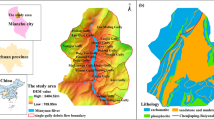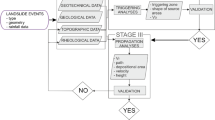Abstract
Debris flows can cause severe loss of human lives and damage to property, especially on densely populated hilly terrains. In the changing climate, the frequency of debris flows is on a rising trend. Therefore, it is important to forecast possible scenarios of debris flows under extreme weather conditions. Previous numerical studies often deal with one individual debris flow in one analysis. Yet a large number of debris flows can occur in a large storm. This paper presents a physically based model to predict likely debris flow clusters on Hong Kong Island with an area of approximately 80 km2 considering the influence of the changing climate. Firstly, a slope stability analysis is conducted, and unstable cells and landslide deposition areas are predicted. Then clusters of debris flows initiating from these landslides are simulated considering hillslope erosion. The models are validated with historical debris flows triggered by a rainstorm in 2008. Finally, debris flow clusters under three reference extreme rainstorms (i.e. 44%, 65% and 85% of the 24-h probable maximum precipitation, PMP) are predicted. With the increase of rainstorm magnitude, numerous debris flows can occur simultaneously and merge, posing much greater threat to society. The consequences of debris flows grow dramatically when the magnitude reaches a certain extent, i.e. 65% of the 24-h PMP.













Similar content being viewed by others
References
AECOM Asia Company Limited, Lin BZ (2014) 24-hour PMP updating study, Agreement No. CE 13/2011 (GE). Geotechnical Engineering Office, Civil Engineering and Development Department, Hong Kong
Au SWC (1998) Rain-induced slope instability in Hong Kong. Eng Geol 51(1):1–36
Bout B, Lombardo L, van Westen CJ, Jetten VG (2018) Integration of two-phase solid fluid equations in a catchment model for flashfloods, debris flows and shallow slope failures. Environ Model Softw 105:1–16
Brunsden D, Prior DB (1984) Slope instability. Wiley, Chichester
Chang DS, Zhang LM, Xu Y, Huang RQ (2011) Field testing of erodibility of two landslide dams triggered by the 12 may Wenchuan earthquake. Landslides 8(3):321–332
Chang WL, Hui TW (2001) Probable maximum precipitation for Hong Kong. ATC3 Workshop on rain-induced landslides, Hong Kong
Chen HX, Zhang LM, Chang DS, Zhang S (2012) Mechanisms and runout characteristics of the rainfall-triggered debris flow in Xiaojiagou in Sichuan Province, China. Nat Hazards 62(3):1037–1057
Chen HX, Zhang LM (2014) A physically-based distributed cell model for predicting regional rainfall-induced shallow slope failures. Eng Geol 176:79–92
Chen HX, Zhang LM (2015) EDDA 1.0: integrated simulation of debris flow erosion, deposition and property changes. Geosci Model Dev 8(3):829–844
Chiang SH, Chang KT, Mondini AC, Tsai BW, Chen CY (2012) Simulation of event-based landslides and debris flows at watershed level. Geomorphology 138(1):306–318
Collins BD, Znidarcic D (2004) Stability analyses of rainfall induced landslides. J Geotech Geoenviron Eng 130(4):362–372
Corominas J (1996) The angle of reach as a mobility index for small and large landslides. Can Geotech J 33(2):260–271
Cui P, Zou Q, Xiang LZ, Zeng C (2013) Risk assessment of simultaneous debris flows in mountain townships. Prog Phys Geogr 37(4):516–542
Dai FC, Lee CF, Wang SJ (1999) Analysis of rainstorm-induced slide-debris flows on natural terrain of Lantau Island, Hong Kong. Eng Geol 51(4):279–290
Drainage Service Department (2008) Flooding blackspots. Drainage Services Department, Hong Kong
Fan RL, Zhang LM, Wang HJ, Fan XM (2018) Evolution of debris flow activities in Gaojiagou ravine during 2008–2016 after the Wenchuan earthquake. Eng Geol 235:1–10
FLO-2D Software Inc (2009) FLO-2D Reference Manual Nutrioso, Arizona, U.S.A
Fredlund DG, Morgenstern NR, Widger RA (1978) The shear strength of unsaturated soils. Can Geotech J 15(3):313–321
Fredlund DG, Rahardjo H (1993) Soil mechanics for unsaturated soils. John Wiley & Sons, Inc, New York
Fyfe JA, Shaw R, Compbess SDG, Lai KW, Kirk PA (2000) The quaternary geology of Hong Kong. Geotechnical Engineering Office, Civil Engineering and Development Department, Hong Kong
Gao L, Zhang LM, Chen HX (2015) Likely scenarios of natural terrain shallow slope failures on Hong Kong Island under extreme storms. Nat Hazards Rev 18(1):B4015001
Gao L, Zhang LM, Chen HX, Shen P (2016) Simulating debris flow mobility in urban settings. Eng Geol 214:67–78
Gardner WR (1958) Some steady-state solutions of the unsaturated moisture flow equation with application to evaporation from a water table. Soil Sci 85(4):228–232
Geotechnical Control Office (1982) Mid-levels study: report on geology, hydrology and soil properties. Geotechnical Control Office, Hong Kong
Han XD, Chen JP, Xu PH, Niu CC, Zhan JW (2018) Runout analysis of a potential debris flow in the Dongwopu gully based on a well-balanced numerical model over complex topography. Bull Eng Geol Environ 77(2):679–689
Han Z, Li Y, Huang JL, Chen GQ, Xu LR, Tang C, Zhang H, Shang YH (2017) Numerical simulation for run-out extent of debris flow using an improved cellular automaton model. Bull Eng Geol Environ 76(3):961–974
Hanson GJ, Simon A (2001) Erodibility of cohesive streambeds in the loess area of the midwestern USA. Hydrol Process 15(1):23–38
He SM, Ouyang CJ, Liu W, Wang DP (2016) Coupled model of two-phase debris flow, sediment transport and morphological evolution. Acta Geologica Sinica-English Edition 90(6):2206–2215
Huang Y, Cheng HL, Dai ZL, Xu Q, Liu F, Sawada K, Moriguchi S, Yashima A (2015) SPH-based numerical simulation of catastrophic debris flows after the 2008 Wenchuan earthquake. Bull Eng Geol Environ 74(4):1137–1151
Hungr O (1995) A model for the runout analysis of rapid flow slides, debris flows, and avalanches. Can Geotech J 32:610–623
Hungr O, McDougall S (2009) Two numerical models for landslide dynamic analysis. Comput Geosci 35(5):978–992
Ho KKS (2013) Managing the uncertainties of natural terrain landslides and extreme rainfall in Hong Kong. Landslide science and practice:285–302
Julien PY, Lan Y (1991) Rheology of hyperconcentrations. J Hydraul Eng 117(3):346–353
King JP (2013) Tsing Shan Debris Flow and Debris Flood, GEO Report No. 281. Geotechnical Engineering Office, Civil Engineering and Development Department, Hong Kong
Ko FWY, Lo FLC (2016) Rainfall-based landslide susceptibility analysis for natural terrain in Hong Kong - a direct stock taking approach. Eng Geol 215:95–107
Lam CLH, Lau JWC, Chan HW (2012) Factual report on Hong Kong rainfall and landslides in 2008, GEO Report No. 273. Geotechnical Engineering Office, Civil Engineering and Development Department, Hong Kong
Li ACO, Lau JWC, Cheung LLK, Lam CLH (2009) Review of landslides in 2008, GEO Report No. 274. Geotechnical Engineering Office, Civil Engineering and Development Department, Hong Kong
Li YM, Ma C, Wang YJ (2017) Landslides and debris flows caused by an extreme rainstorm on 21 July 2012 in mountains near Beijing, China. Bull Eng Geol Environ 3:1–16
O’Brien JS, Julien PY (1988) Laboratory analysis of mudflow properties. J Hydraul Eng 114(8):877–887
Ouyang C, He S, Tang C (2015) Numerical analysis of dynamics of debris flow over erodible beds in Wenchuan earthquake-induced area. Eng Geol 194:62–72
Pudasaini SP (2012) A general two-phase debris flow model. J Geophys Res: Earth Surf 117:F03010
Shen P, Zhang LM, Chen HX, Fan RL (2018) EDDA 2.0: integrated simulation of debris flow initiation and dynamics considering two initiation mechanisms. Geosci Model Dev 11(7):2841–2856
Staley DM, Kean JW, Cannon SH, Schmidt KM, Laber JL (2013) Objective definition of rainfall intensity–duration thresholds for the initiation of post-fire debris flows in southern California. Landslides 10(5):547–562
Takahashi T, Nakagawa H, Harada T, Yamashiki Y (1992) Routing debris flows with particle segregation. J Hydraul Eng 118(11):1490–1507
World Meteorological Organization (2009) Manual on estimation of probable maximum precipitation (PMP). WMO-No. 1045, Geneva
Zhang LL, Zhang J, Zhang LM, Tang WH (2011) Stability analysis of rainfall-induced slope failures: a review. Geotech Eng Proc Instit Civ Eng 164(5):299–316
Zhang N, Matsushima T, Peng NB (2018) Numerical investigation of post-seismic debris flows in epicentral area of the Wenchuan earthquake. Bull Eng Geol Environ:1–16. https://doi.org/10.1007/s10064-018-1359-6
Zhang S, Zhang LM (2017) Impact of the 2008 Wenchuan earthquake in China on subsequent long-term debris flow activities in the epicentral area. Geomorphology 276:86–103
Zhang S, Zhang LM, Glade T (2014) Characteristics of earthquake- and rain-induced landslides near the epicentre of Wenchuan earthquake. Eng Geol 175:58–73
Zhang S, Zhang LM, Chen HX, Yuan Q, Pan H (2013) Changes in runout distances of debris flows over time in the Wenchuan earthquake zone. J Mt Sci 10(2):281–292
Zhu H, Zhang LM, Xiao T, Li XY (2017) Enhancement of slope stability by vegetation considering uncertainties in root distribution. Comput Geotech 85:84–89
Zhu H, Zhang LM (2015) Evaluating suction profile in a vegetated slope considering uncertainty in evapotranspiration. Comput Geotech 63(1):112–120
Acknowledgements
The authors acknowledge the support from the Research Grants Council of the Hong Kong SAR (no. C6012-15G and no. 16206217).
Author information
Authors and Affiliations
Corresponding author
Rights and permissions
About this article
Cite this article
Zhou, S.Y., Gao, L. & Zhang, L.M. Predicting debris-flow clusters under extreme rainstorms: a case study on Hong Kong Island. Bull Eng Geol Environ 78, 5775–5794 (2019). https://doi.org/10.1007/s10064-019-01504-3
Received:
Accepted:
Published:
Issue Date:
DOI: https://doi.org/10.1007/s10064-019-01504-3




